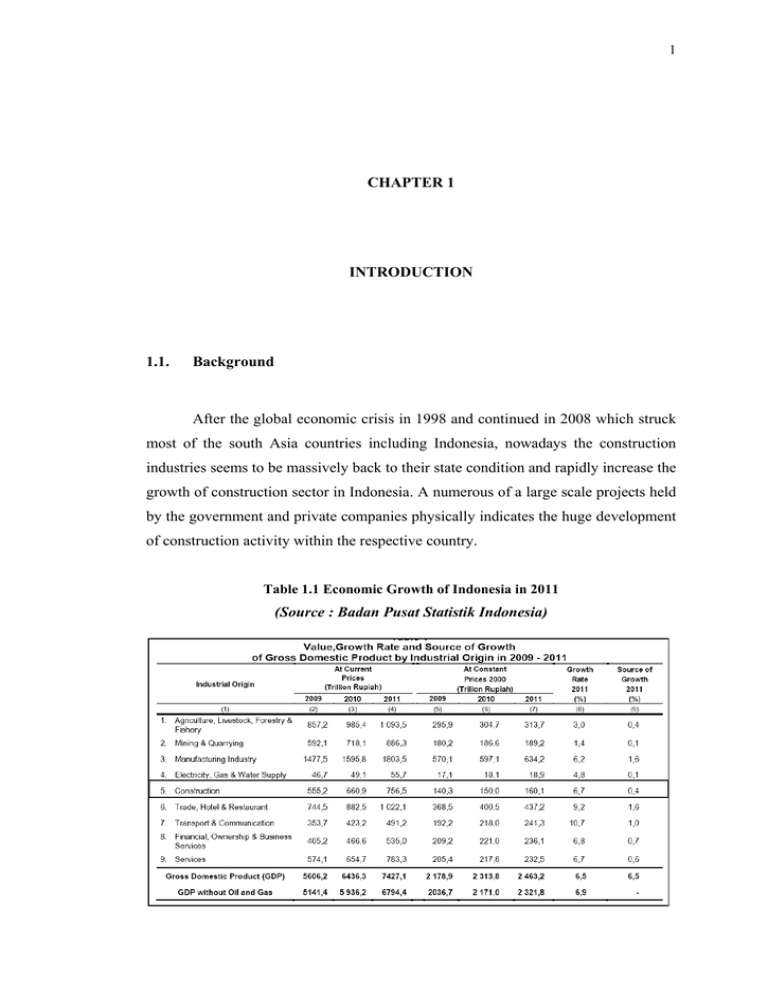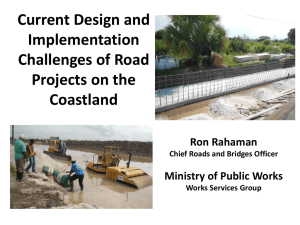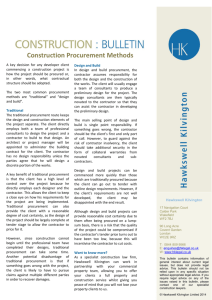CHAPTER 1 INTRODUCTION 1.1.
advertisement

1 CHAPTER 1 INTRODUCTION 1.1. Background After the global economic crisis in 1998 and continued in 2008 which struck most of the south Asia countries including Indonesia, nowadays the construction industries seems to be massively back to their state condition and rapidly increase the growth of construction sector in Indonesia. A numerous of a large scale projects held by the government and private companies physically indicates the huge development of construction activity within the respective country. Table 1.1 Economic Growth of Indonesia in 2011 (Source : Badan Pusat Statistik Indonesia) 2 In order to deliver a succession of construction procurement, it is involving a multi-diciplinary and many experts such as Value Manager, Architects, Engineers, Quantity Surveyors, Contractors and many more. Among those parties who involves in the process of construction procurement, contractor is one of the party which has a role as the bridging finance by carrying out the work physically until the building is ready to be handed over to the client. It means that, the contractor is the one who will be face to face with the various kind of risks even from the earlier stage of their effort in order to get the projects until the contractual duty is ended. As the party who is likely having the biggest risk on their hand in construction phase, such a serious step of anticipation should be taken as early as possible and make it effective in succeeding the subsequent phases. The earliest phase to be done by contractor before proceeds into construction commencement in the procurement process is the ‘precontract’ which can be called as the tendering phase. CONSTRUCTION PROCUREMENT MAIN PROCESS PREPARATION DESIGN TENDER CONSTRUCTION Figure 1.1 Royal Institute of British Architect’s (RIBA) Outline Plan of Procurement (Source : J.W.E Masterman, 2002) In contractor companies, tendering activities normally conducted as a part of marketing division to fulfill their business target-plan. Tendering is a commercially based function that uses the estimate of cost as a basis upon which the final price is determined and submitted to the clients. Since the construction project is used to have a specific criteria, cost estimate is one important factor that should be considered in order to make a decision by getting a competitive and profitable price and proceed with a tender submission then getting the award. This estimating and tendering phase itself is not as simple as putting a documents to the client. The participants need some particular organization and administration function as well as strategically analyze and evaluate the project tender conditions earlier to minimize 3 the tender loss and the more important is to make the costs of tendering become worthwhile for running the project itself. In summary, tendering phase can be said as the starting point for the life cycle of contractor companies which bring them to the next step to complete the procurement processes. Without a continuous project achievement, many of the private owned even the state owned-contractor company may stop their business and went into insolvency. But in the other hand, participating in so many tender activities does not merely a good strategy either if we do not know how to do an effective tender strategy. Therefore, some kind of proper assessment system is required to optimize the result of tendering in order to get a project award and furthermore leaves no tendering cost in vain. Although a certain experienced contractor companies have their own trust worthy system for strategic tendering, in practical there are still many which did not exercise the system for a various reasons. Within this study, an analysis will be performed through particular method in order to identify the problems that makes the procurement activities become ineffective which at the end, it may leads to a serious problem. And for the conclusion, provide an appropriate recommendation to resolve the problem found. 1.2. Statement of Problem According to the previous section, for the contractor company, procurement activity plays an important role in determining company’s future life. Capable to get as much profitable project as possible is likely the main goal of every contractor company. But in order to achieve the goal, the pre-contract stage is the first obstacle that the contractor must pass. Normally, in a well-settled contractor company, some kind of Standard Operating Procedure (SOP) has been made through a long history and had experienced a lot of evaluations, corrections and improvements. Unfortunately, in the actual practice, the SOP sometimes is only a heap of paper-works and then the 4 contractors are still having a mindset that participating as many project tender as possible without knowing their own strength and weakness is likely how they are ‘trying’ to achieve the company’s target revenue and this should be the very first problem. In Indonesia, there are more than a hundreds of contractor establishment qualified in grade 6 – 7 either established by private or the government. These contractors are qualified to work on a large-scale project with the production cost above Rp. 10.000.000.000 or equivalent to 3,3 million Ringgit, but once again unfortunately, based on the common experience, these high-grade contractors are still having a problem to initiate a proper procurement strategy of their own at the earlier stage in order to achieve their goal and result to a repeatedly failure in getting a project award. This phenomenon leads to an interesting case study to discover the actual procurement performance done by the contractor. In this case, one of the contractor companies in Indonesia will be chosen as the object of the research. Amongst numerous of construction company in Indonesia in the number up to 151.000 establishments (See figure 1.5) ranged from grade 1 until 7 of qualification includes the non-registered companies, one of the State-owned Enterprise (SOE) will be observed within this research by considering several reasons as follows : a) SOE is well-established company in terms of corporate status as organized under the law; b) Most of the companies have been established by the process of nationalization of a Dutch company during the colonialism era of Indonesia which mean they are having more than 50 years of experience. Therefore, the business systems and procedures are properly established; c) Construction market in Indonesia still being dominated by the SOE, so that, it is not so difficult to trace their track record in order to identify their performance; 5 d) All SOE have the grade 7 of qualification, means they have a wide range opportunity in participating construction tender and certainly be able to participate in a large-scale project with the production cost Rp. 10.000.000.000 and above or equivalent to 3,3 million Malaysia Ringgit and above; e) SOE is where the author is currently work on now. In the context of project procurement, SOE has already established such a procedure for procurement process in order to regulate the sequence of executing the procurement activity like the folowing example adopted from one of the state-owned contractor company’s procedure starting from : i. Determining market segmentation, targeting and positioning; ii. Fulfilling the customer’s needs and other requirements; iii. Creating and maintaining customer relationship; iv. Evaluation on customers satisfactory. Within these steps, every company which adopt such procedure supposed to have an effective way to select the potential tender invitation and maintain all the risk. But the most critical problems which arise along the way are as follows : a) The increment of construction establishment giving effect to the number of bidder participates in most tendering event which is not less than 10 contractors, indicates that the level of competition is getting higher nowadays as seen on the table below; 6 Table 1.2 Number of Registered Grade 6 - 7 Contractor in Indonesia, 2012 (Source : Association of Indonesian Contractor/AKI) 1st quarter 2012 Year Grade No. of Registered Contractor 6 7 107 18 Table 1.3 Number of Construction Establishment by Province, 2004 - 2009 (Source : Badan Pusat Statistik Indonesia) b) Numerous of tender schedule to follow (up to 45 tenders / month) with relatively low success rates could be a serious problem due to corporate growth; Table 1.4 Waskita Karya’s Tender Report as per December 2005 (Source : Marketing Department PT. Waskita Karya (Persero)) 7 c) Wrongful market positioning against external market trend in terms of type of construction; Table 1.5 Value of Construction Completed by Type of Construction, 2004 - 2009 (Source : Badan Pusat Statistik Indonesia) d) Lack of tendering evaluation, strategy and assessment maintained by the company in order to reduce failure on the future tendering activities. Those following events will simply leads to the second problem, which is the economic aspect. Since every single activity in order to obtain a tender award had its own cost, it means that the more tender which we are participated into, the more cost required to run the preparation. 1.3. Objectives The aims to be achieved in this study are as follows: a) To determine the contractor’s project procurement performance by: i. Identifying the company profile and its business strategy; ii. Identifying the categories of projects tendered and awarded; and 8 iii. Identifying the degree of accomplishment against company target in procurement activity. b) To identify the strength and weakness in procurement based on the success rates and procurement performance, and also possible areas for improvement in procurement process especially at the tendering phase. 1.4. Research Question Flowing from the background and statement of problem to the objectives of study, there must be a particular questions to be answered within the research which can be listed as follows : a) How is the procurement process in a contractor company? b) What is the most critical problem which may hold up the procurement performance within the time-series in the case study? c) How to figure out the degree of accomplishment in tendering activity? d) How to evaluate the procurement performance and identify the company’s strength, and weakness as an important reference to decide the appropriate strategy for the upcoming procurement activities? 1.5. Scope of Study Generally the scope of the study is limited to: a) Procurement phase particularly in tendering and internal evaluation process. 9 b) The study will be focused on the procurement activity done by one of the state-owned contractor firm in Indonesia, PT. Waskita Karya (Persero). c) Criteria of performance to be analyzed based on the related company’s Standard Operating Procedure (SOP). 1.6. Importance of Study For the contractor : a) The result can be used as a reference in identifying the risk which may be appear during the tendering activity process. b) As a reference in decision making and evaluation of procurement performance. c) As a contribution for the development of procurement assessment strategy in order to achieve effectiveness and efficiency, profitable project and the business growth. d) Provide a simple method and input as to enrich the reference for contractor firm to be applied for dealing with procurement problems. For the author : a) As a study in understanding the implementation of time-series analysis to determine the procurement performance. b) To be acquainted with the various kind of risks which arise in the process of tendering as well as determine a responsive action. 10 1.7. Organization of Dissertation The dissertation consist of five main chapters : Chapter I Introduction The explanation of background of study, problem statement, objectives of study, scope of study, importance of study, research methodology and organization of dissertation. Chapter II Literature Review This section firstly provides a detail explanation to the relevant theory of precontract phase in construction procurement process and secondly presents the profile of the contractor company which being the object of the case study. Chapter III Research Methodology This section describes the procedures and the method utilized in the research. Which describe the object of study, method for data collecting, and analysis method. Chapter IV Analysis and Discussion This chapter will analyze the data which has been collected and get into discussion to obtain a result of this research. Chapter V Conclusion and Recommendations Provide the final conclusion of the research and recommendation for future research.



